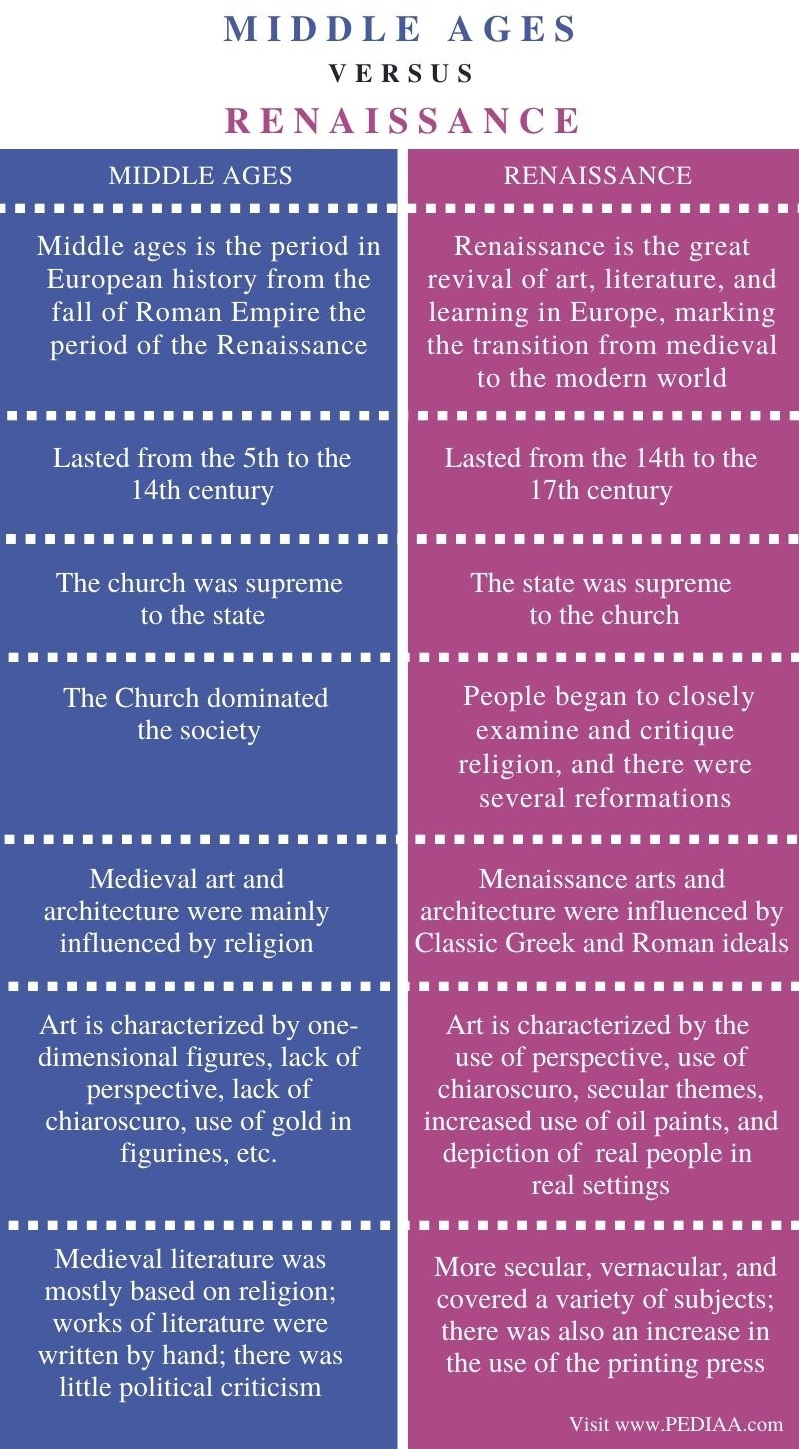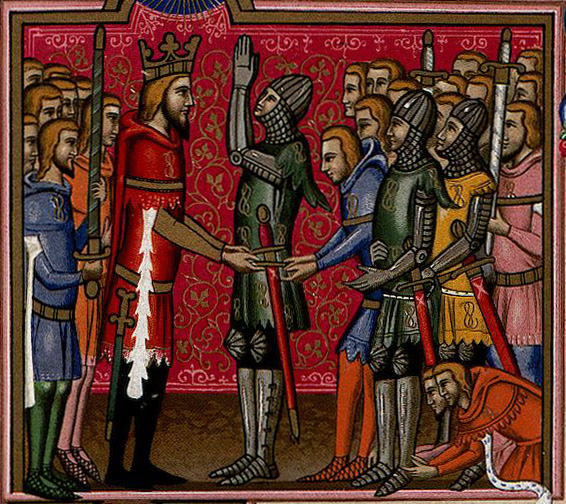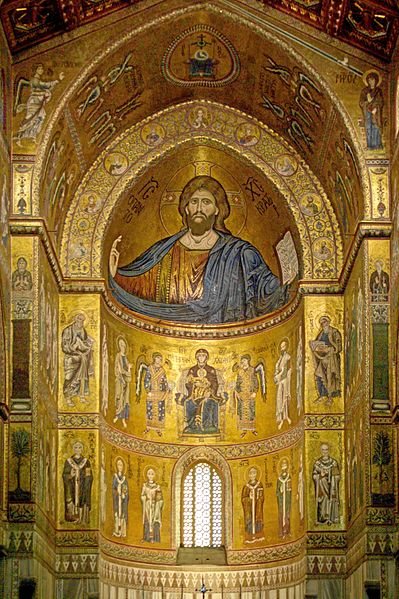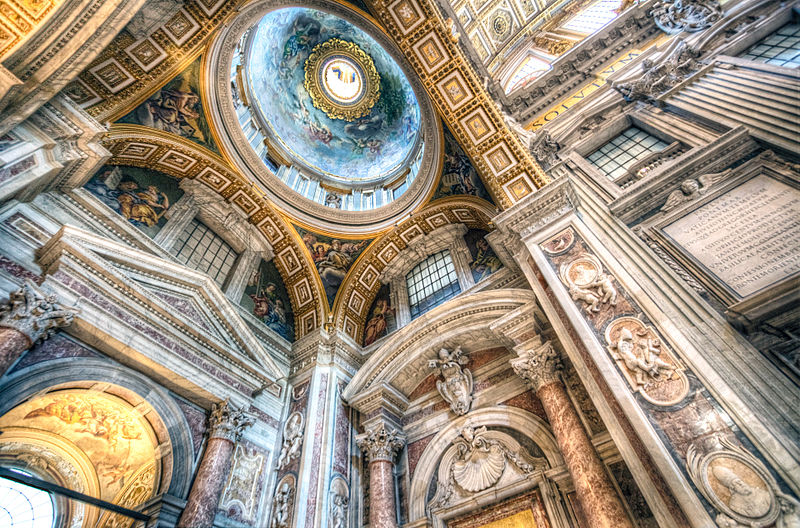The First Part of the Middle Ages Marked by a Decline of Art and Learning for Kids
The master deviation between heart ages and renaissance is that renaissance was the menstruation of the great revival of art, literature, and learning in Europe, marking the transition from medieval to the modern world.
In that location are three traditional divisions of Western history: classical antiquity, medieval catamenia/heart ages, and the modernistic period. The eye ages period began afterward the fall of the Roman Empire. Renaissance is the menstruum that followed the center ages. It is the span between the Middle Ages and Modern history. Renaissance saw desperate changes and developments in many areas, such as cultural, social, economic, and political.
Fundamental Areas Covered
ane. What is Centre Ages
– Definition, Lodge, Art and Architecture, Literature
2. What is Renaissance
– Definition, Art and Architecture, Literature
iii. What is the Difference Between Heart Ages and Renaissance
– Comparison of Key Differences
Key Terms
Medieval Era, Middle Ages, Renaissance
What is Middle Ages
Middles ages is as well known as the medieval era. The center ages of European history is between the autumn of the Roman Empire and the offset of the Renaissance. This period lasted from the 5th to the late 14th century. This is the heart period of the traditional divisions of Western history: classical antiquity, medieval period/eye ages, and the modern period. The medieval flow itself has 3 divisions: early on, high and late centre ages.
After the autumn of the Roman empire, the Catholic Church became the almost powerful establishment of that period. In fact, the centre of medieval life is the Church. Kings and queens of this period derived power from the Church. The nobles and the Church building-owned most of the land and belongings. The systems of bullwork and manorialism were pop during this era.
Medieval Social Structure
There were three distinct classes in medieval social club: lords, vassals, and fiefs. The male monarch (lord) endemic all the country, and he gave out parcels of country nobles (vassals) who would hope loyalty and service to the king. The nobles, in turn, rented out their packet of land to peasants (fiefs). Nevertheless, before the king granted land to someone, he had to make that person a vassal. This was done at a citation anniversary that consisted of the two-office act of homage and oath of fealty. During this, the king and vassal entered into a contract – the vassal promised to fight for the king at his command, while the king agreed to protect the vassal from an external forcefulness.

Figure one: Investiture of a Knight
Medieval Art and Compages
Medieval fine art and architecture consist of many styles, including early Christian and Byzantine, Anglo-Saxon and Viking, Carolingian, Insular, Ottonian, Romanesque, and Gothic. The art and architecture mainly centred around the Church. Cathedrals were the largest buildings in medieval towns. Moreover, medieval art is an illustration of the passionate interest and idealistic expression of the Christian faith.

Effigy 2: Byzantine Monumental Church Mosaics
Medieval Literature
Medieval literature was also based on religious. Death and resurrection, good and evil, and sky and World were recurrent Christian themes in works of literature. The code of chivalry and courtly love were too famous themes in medieval literature. Most of the early on literature of the middle ages were too bearding. Beowulf, Pearl Poet's Pearl, Patience, Cleanness, and Sir Gawain and the Light-green Knight, John Gower's Confessio Amantis, Langland's Piers Plowman, and the works of Geoffrey Chaucer including Canterbury Tales are examples of medieval literature.
Nigh of the piece of work used Christian themes such as decease and resurrection, good and evil, and sky and Earth. The lawmaking of chivalry and courtly dearest were also famous themes in medieval literature.
End of the Heart Ages
Between 1347 and 1350, the bubonic plague, which was then known every bit the "Blackness Death" killed thousands of people in Europe. 30% of Europe's population died as a result of this affliction. Middle ages was a period marked past wars, famines, and plagues. Hence, people also call it the "Nighttime Ages".
During the 11th century, feudal life began to change with the introduction of various agricultural innovations. Farming became efficient and productive and required merely fewer farm. Consequently, more and more people moved to towns and cities. In the meantime, the Crusades had expanded merchandise routes to the East, and at that place was a huge expansion in trade and commerce. By the fourteenth century, a new era chosen the Renaissance was born.
What is Renaissance
Renaissance that a flow in the history of Europe that followed the Medieval period. The Renaissance period ranges from the 14th to the 17th century and is deemed the bridge between the Eye Ages and Modernistic history. This period saw drastic changes and developments in many areas, such as cultural, social, economical, and political. The proper noun "Renaissance" comes from the French word which has the meaning "rebirth". Many people at that showed an involvement in classical learning, especially the learning of Aboriginal Hellenic republic and Rome. For these people, Renaissance was the fourth dimension of rebirth afterward the disorder and devastation of the middle ages. During the Renaissance, in that location were many famous artists, writers, philosophers, and geniuses.
Renaissance began in Italian republic, but it before long spread across the whole of Europe. Italian republic is the birthplace of the Renaissance since it was the middle of aboriginal Rome and Roman history and was a very rich country at the time with wealthy patrons supporting many artists and geniuses.
Renaissance Art and Architecture
Renaissance was a gilt age for the arts and architecture. There are numerous art and architectural achievements that are nonetheless very famous today. Many infrequent artists and architects such every bit Donatello, Leonardo da Vinci, Michelangelo, Raphael, Sofonisba Anguissola, Filippo Brunelleschi, and Artemisia Gentileschi, and showed their uniqueness and creativity.
Renaissance architecture focused on symmetry, geometry, proportion, and the regularity of parts, following the style of classical antiquity. Palazzo Farnese, The Sistine Chapel, Basilica of St. Peter, and El Escorial are examples of renaissance architecture. Mona Lisa and The Last Supper by Da Vinci, The Birth of Venus by Botticelli and The Creation of Adam by Michelangelo Buonarroti are some examples of renaissance paintings. Paintings of this era often used unnatural shapes, linear perspective, and depth perception.

Figure 3: Inside of St Peter's Basilica
Renaissance Literature
The introduction of the printing press led to the flourish of renaissance literature. Renaissance literature was mainly influenced by the ideas of Renaissance art, politics, and religion. Information technology was also profoundly influenced past Greek and Roman literature. Drama and verse were the most pop forms of renaissance literature.
The renaissance writers explored religious and social themes in their piece of work; the religious themes were ofttimes explored with a completely unlike approach than the medieval writers—for example, John Milton's Paradise Lost and Christopher Marlowe's Doctor Faustus. Dante Alighieri, Giovanni Boccaccio, Miguel de Cervantes, Edmund Spenser, William Shakespeare, Sir Philip Sidney, Christopher Marlowe, John Donne and George Herbert are some notable figures in Renaissance literature.
Important Discoveries during Renaissance
Renaissance gave birth to many new ideas, cultures, religions, and ways of life. It helped people change the manner that they saw themselves and the world. Many people expressed their uniqueness and inventiveness through art, technology, science, and writing. Moreover, in that location were many scientific discoveries, mathematical advances, and theorems. Items similar the printing press, guns, compasses, watches, and telescopes were invented during this period. In addition to these, scientists and doctors besides discovered new information virtually the human body and brought almost many changes in the field of medicine.
Difference Between Middle Ages and Renaissance
Definition
Eye ages is the period in European history from the fall of Roman Empire the catamenia of the Renaissance while renaissance is the peachy revival of art, literature, and learning in Europe, marking the transition from medieval to the modern world.
Time Period
Middle ages lasted from the 5th to the 14th century while the renaissance menstruation lasted from the 14th to the 17th century.
Religion
During the middle ages, the Church dominated the club; the church was supreme to the country. In contrast, during the renaissance, the state was supreme to the church. Moreover, there were several reformations in the religion, and people began to closely examine and critique religion.
Art and Architecture
Medieval art and compages were mainly influenced by religion, while renaissance arts and compages were influenced past Classic Greek and Roman ideals. Medieval art is characterized by 1-dimensional figures, lack of perspective, lack of chiaroscuro, use of aureate in figurines, etc. while renaissance fine art is characterized past the utilise of perspective, apply of chiaroscuro, secular themes, increased utilise of oil paints, and depiction of existent people in real settings.
Literature
Medieval literature was mostly based on religion; works of literature were written by hand; there was lilliputian political criticism. Renaissance literature was more secular, vernacular, and covered a variety of subjects. There was too an increase in the utilize of the printing printing.
Conclusion
When compared to eye ages, during renaissance at that place were drastic changes and developments in many areas, such every bit cultural, social, economical, and political. As its name suggests, it's a period of revival art, literature, and learning. Thus, this is the main departure between middle ages and renaissance.
Reference:
i. "Middle Ages." History.com, A&E Telly Networks, 22 Apr. 2010, Available hither.
two. "Overview of the Renaissance." Anglefire, Available here.
three. "Renaissance." History.com, A&E Television set Networks, 4 Apr. 2018, Available here.
Paradigm Courtesy:
1. "Louis I of Naples – Order of the Knot" (Public Domain) via Commons Wikimedia
two. "Monreale BW 2012-10-09 09-52-40" By Berthold Werner – Own work (CC BY-SA 3.0) via Commons Wikimedia
3. "Ceiling of St Peter'southward Basilica" By Anne Dirkse (www.annedirkse.com) – Own work (CC BY-SA iv.0) via Commons Wikimedia

Source: https://pediaa.com/what-is-the-difference-between-middle-ages-and-renaissance/
0 Response to "The First Part of the Middle Ages Marked by a Decline of Art and Learning for Kids"
Post a Comment